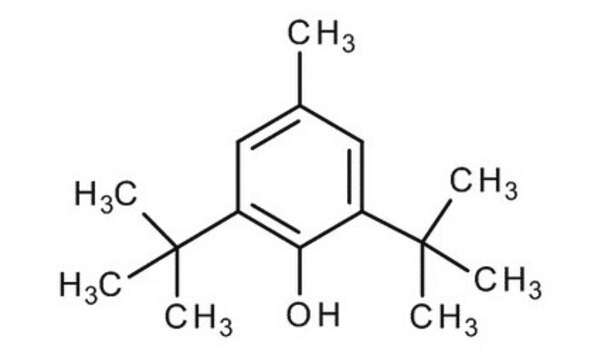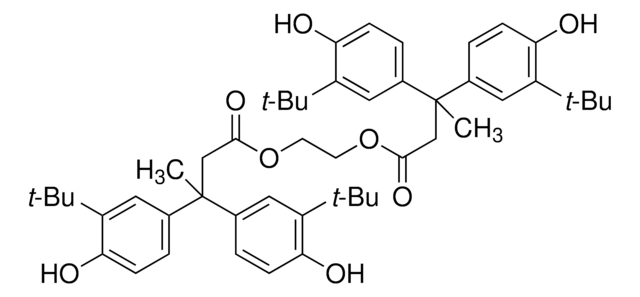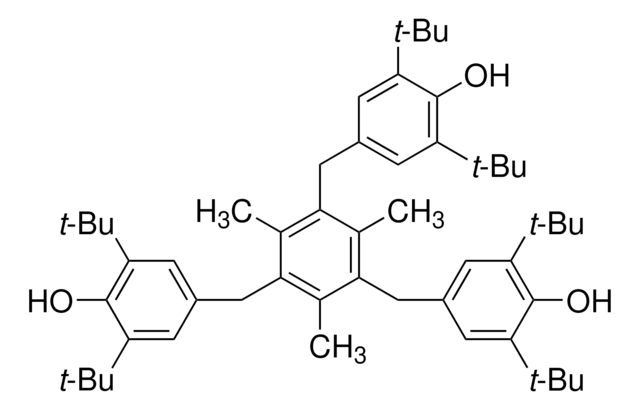B1215000
2,6-Di-tert-butyl-4-methylphenol
European Pharmacopoeia (EP) Reference Standard
Synonyme(s) :
Butylhydroxytoluène, Hydroxytoluène butylé
About This Item
Produits recommandés
Qualité
pharmaceutical primary standard
Densité de vapeur
7.6 (vs air)
Pression de vapeur
<0.01 mmHg ( 20 °C)
Température d'inflammation spontanée
878 °F
Fabricant/nom de marque
EDQM
pb
265 °C (lit.)
Pf
69-73 °C (lit.)
Application(s)
cleaning products
cosmetics
food and beverages
personal care
pharmaceutical
Format
neat
Température de stockage
2-8°C
Chaîne SMILES
Cc1cc(c(O)c(c1)C(C)(C)C)C(C)(C)C
InChI
1S/C15H24O/c1-10-8-11(14(2,3)4)13(16)12(9-10)15(5,6)7/h8-9,16H,1-7H3
Clé InChI
NLZUEZXRPGMBCV-UHFFFAOYSA-N
Vous recherchez des produits similaires ? Visite Guide de comparaison des produits
Description générale
Application
- Multicomponent analysis of fat- and water-soluble vitamins and auxiliary substances in multivitamin preparations by qNMR.: This study utilizes Butylhydroxytoluene (BHT) as an auxiliary substance for its antioxidant properties in multivitamin preparations. The research demonstrates the effectiveness of BHT in maintaining the oxidative stability of vitamins, ensuring their longevity and efficacy in pharmaceutical applications (Eiff et al., 2015).
- Investigation of the stabilizing effects of antioxidants and benzophenone-3 on desonide photostability.: The study explores the use of BHT as an antioxidant to enhance the photostability of desonide. Findings indicate that BHT significantly improves the stability of the compound under light exposure, making it a valuable preservative in pharmaceutical and biotechnological formulations (Rosa et al., 2014).
- Understanding the molecular aspects of tetrahydrocannabinol and cannabidiol as antioxidants.: This research highlights BHT′s role as a comparative antioxidant in studying the properties of cannabinoids. BHT′s well-documented antioxidant mechanisms provide a benchmark for evaluating the efficacy of other compounds in oxidative stress research (Borges et al., 2013).
- Kinetic study of the quenching reaction of singlet oxygen by common synthetic antioxidants.: The kinetic analysis of BHT′s ability to quench singlet oxygen demonstrates its superior antioxidant capabilities compared to other synthetic antioxidants. This property is crucial for developing pharmaceutical formulations that require high oxidative stability (Kim et al., 2009).
Conditionnement
Autres remarques
Produit(s) apparenté(s)
Mention d'avertissement
Warning
Mentions de danger
Conseils de prudence
Classification des risques
Aquatic Acute 1 - Aquatic Chronic 1
Code de la classe de stockage
11 - Combustible Solids
Classe de danger pour l'eau (WGK)
WGK 2
Point d'éclair (°F)
260.6 °F - open cup
Point d'éclair (°C)
127 °C - open cup
Faites votre choix parmi les versions les plus récentes :
Certificats d'analyse (COA)
Désolés, nous n'avons pas de COA pour ce produit disponible en ligne pour le moment.
Si vous avez besoin d'assistance, veuillez contacter Service Clients
Déjà en possession de ce produit ?
Retrouvez la documentation relative aux produits que vous avez récemment achetés dans la Bibliothèque de documents.
Les clients ont également consulté
Protocoles
HPLC Analysis of Phenolic Antioxidants on Ascentis® Express C18 2.7 μm
Notre équipe de scientifiques dispose d'une expérience dans tous les secteurs de la recherche, notamment en sciences de la vie, science des matériaux, synthèse chimique, chromatographie, analyse et dans de nombreux autres domaines..
Contacter notre Service technique








